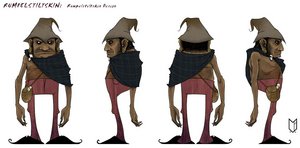|
The Rumpelstiltskin Aesthetic

Having a name like Rumpelstiltskin, which means "little rattle stilt" (little goblin/poltergeist) in German, causes
the reader to assume a certain physical aesthetic of this demonic little character. In almost every illustration one can 'Google'
of Rumpelstiltskin, he is wretched, pathetic and usually fairly ugly. Indeed, the picture painted of Rumpelstiltskin is one
of a true antagonist. The irony of this is that Rumpelstiltkin is probably the only character in the tale that actually gives
the Miller's daughter a chance (this being the guessing of his name.) His character is always devilish; His tactic is always
bargaining, but he must abide by his own rules of the game.
The idea of Rumpelstiltskin representing the devil is a strong case when it comes to his character and actions throughout.
Especially in the 1857 Grimm's version, Rumpelstiltskin gets so angry, he tears in half down the centre of his body (if that
isn't creepy demonic behaviour, I don't know what is.) Also, much like Milton's "Paradise Lost," a demon's nomenclature
becomes an important issue because demons do not retain their names that they had in heaven. Knowing the true name of a demon
would indicate power over that demon.
Spinsters
The idea of the Spinster and the Spinning Wheel is a complex one, and it takes on many symbolic roles in folk and fairy tales.
In Rumpelstiltskin it is clearly a great skill and gift to be an expert spinner (valued by both family and royalty.) In the
historical concept, it is also a strong symbolic truth that the mastery of this craft was often difficult to achieve by many
women. In the book "Spiders and Spinsters," Marta Weigle notes that Rumpelstiltskin and other AT-500 types (see
below) explored the "doubts about one's womanly competence, anger at difficult or dreary tasks, fear of failure or of
not winning a mate" (30.) Weigle also explores other imagery of the spinster, often not coinciding with this symbolic
nature - sometimes becoming a Spinster was feared (because of deformity or age.) This polar opposite concept can be seen in
stories from the same cultural background (i.e. Sleeping Beauty.)
Aarne-Thompson Types
The Aarne-Thompson Types is a catalog of fairytales (and some folktales recorded through various means) and is divided into
five separate categories. Rumpelstiltskin is AT type 500 - referring to "The Name of the Helper." Type 500 falls
into the category of "Ordinary Fairy Tales" which refers to those tales of magic, religion, philosophy and romance
tales and (oddly enough) tales of stupid ogres. More than half of the AT fairytale types fall into this category. The four
other categories are animal tales, jokes and anecdotes, formula tales and unclassified tales.
One of the biggest problems with narrowing down Aarne-Thompson Types is that the one description of the motif (e.g., AT-500,
"The Name of the Helper") becomes the defining factor of the story. Indeed, naming the helper is the climax of this
story, but it neglects issues that are equally important in the tale. For example, Rumpelstiltskin could also be named "Where
the helper requests unfair collateral" or "A girl in impossible situations who is aided by a helper." In essence,
the descriptions that define these types are arbitrary, and also become more and more difficult to use, as fairy tales and
various versions of older fairy tales in contemporary times become more complex and unpredictable.
|
